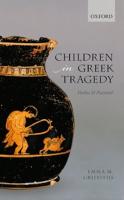
OUP (2020) h/b 336pp £75 (ISBN 9780198826071)
Young children make only rare appearances in Greek tragedy, even less so in speaking or singing roles. In Sophocles’ Ajax, the hero’s young son Eurysaces has a non-speaking part; he is lifted up to hear his father’s final wishes and later assists in performing a funerary ritual. In Euripides’ Andromache, the heroine and her son sing alternate strophes in expectation of his imminent execution. In Alcestis, the son sings two strophes of lament. In each case, the child is a piteous victim of a cruel world. Circumscribed by the conventions of Dionysiac theatre, his character is idealized, a masked symbol of innocence and vulnerability.
Apart from these last performers and a choral presence in Sophocles’ Oedipus Tyrannus and Euripides’ Heraclidae and Suppliant Women, the only childlike voices are the offstage cries of the doomed siblings in Euripides’ Medea. In Oedipus Tyrannus, the daughters are anonymized and silent. Astyanax in the Trojan Women and Polymestor’s sons in Hecuba are murdered silently offstage. Orestes in Iphigenia in Aulis is a babe in his sister’s arms. In the Suppliant Women, the Heraclidae and Hercules, the sons are silent. Professor G. M. Sifakis in the Bulletin of the Institute of Classical Studies (1979) provides an eleven-page account of voiced and unvoiced child roles.
G.’s book relies on such limited evidence, her own instincts and a 54-page bibliography. The fundamental question she asks is what insights can be provided by applying modern principles of particle physics to ancient theatre. She argues that the ‘pathos’ of child figures in Greek tragedy is inextricably linked to their dangerous ‘potential’—the threat they will pose if allowed to grow up, and their ‘multiple future roles’ where ‘past/present/future time’ are manipulated like ‘temporal palimpsests’. Child figures in Greek tragedy are dramatically powerful because they exist in a ‘quantum superposition state’.
G. excludes from detailed analysis children in their teens. She sees Iphigenia in Iphigenia in Aulis and Polyxena in Hecuba as ‘dramatic adults’ and dismisses Polyxena as the ‘dead woman walking’. With regard to younger children, she challenges Sifakis’s analysis, complaining that, like G. M. Grübe in The Drama of Euripides, he sees them as ‘miniature adults’. In fact, Sifakis wrote ‘There is little doubt that Grübe is wrong’. He endorsed the more nuanced view of A. M. Dale in her edition of Alcestis that ‘childishness on stage … would be unthinkable within the Greek tragic convention.’
What did the Athenian audience make of these pitiful child figures of myth and their distraught mothers? Why did Euripides in particular choose to construct theatrical drama around them, in song and dance, whose dramatic power is overlooked by G., as well as in speech? D. W. Lucas in The Greek Tragic Poets (not listed by G.) points to the Greek experience of war, displacement and slavery. Part of Euripides’ aim, he argues, was to attack myth as a source of moral authority. G.’s suggestion that ‘all child figures on the tragic stage have a ghostlike quality’ (her italics) seems extraneous to this debate, but she writes interestingly of the imagery surrounding the child, often described as a fledgling bird sheltering under its mother’s wing, and sometimes as a lion’s cub, which support her thesis of ‘pathos and potential’.
G.’s challenging assessment deserved stronger editorial input from the OUP. ‘Glaukon’s mirror’ on page 7 is not explained until 190 pages later. G.’s vocabulary of ‘problematize’, ‘synoptic’, ‘deictic’, ‘reify’, ‘metatheatrical’ and ‘hypercorism’ (sic), and terms like ‘floating signifier’, ‘social constructionism’ and ‘Universal Child ideology’, could have been leavened before going to press. Stronger editing would have corrected sentences like the following which diminish a potentially interesting argument (pp.158-9):
‘Actors become multiple characters through the assumption of a mask, Athenian ritual, civic space is transformed into a space in Thebes, or Troy, is moved from present to past, and can even become a different space/time portion of Athens, as in the trial scene of Aiskhylos’ Erinyes, which moves the present-time Theatre of Dionysos a little way down the road and back into history.’
An Index of quoted passages would also have been helpful. An extract from Hecuba is quoted twice (pp. 110 and 140), each with a different translation, and the same occurs with Medea (pp. 152 and 156). There are several translation issues. In Ajax (p.57), the funerary ritual requires the cutting off of hair; τέμνω does not mean ‘pull out’. In Andromache (p.106), τί πάθω means ‘What is to become of me?’ not ‘What am I going to do?’. In Medea (pp.75-6), ‘Your mother is stewing in pain and anger’ does little justice to μήτηρ / κινεῖ κραδίαν, κινεῖ δὲ χόλον.
This is a brave book with novel perspectives. Despite its narrow focus and occasional lack of rigour, G’s principal arguments merit consideration and the book deserves a home in specialist libraries.
Stuart Lyons
